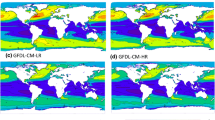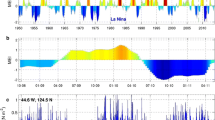Abstract
Data from climatology (World Ocean Atlas) and two large scale operational ocean models (Forecasting Ocean Assimilation Model (FOAM), UK Met. Office and the Navy Coastal Ocean Model (NCOM), US Naval Research Laboratory) are used to give initial and open boundary conditions for a northeast Atlantic implementation of the Proudman Oceanographic Laboratory Coastal Ocean Model System (POLCOMS). We study the effects of using the different datasets on the temperature fields and the circulation. On the continental shelf, comparisons of POLCOMS output with Advanced Very High Resolution Radiometer sea surface temperature data suggest that the effect of using different ocean model initial and boundary conditions is small and that, after 15 months of model time, the impact of the different initial conditions is negligible. Stronger evidence of influence is seen in the deeper oceanic regions of the domain. Volume fluxes through sections governing flow into and out of the North Sea, through the Irish Sea and along the shelf edge show that the impact of the different boundary conditions is small on the shelf but significant elsewhere. These results are contrasted with the use of climatology to assess the value of these Global Ocean Data Assimilation Experiment ocean model products.










Similar content being viewed by others
References
Antonov JI, Locarnini RA, Boyer TP, Mishonov AV, Garcia HE (2006) World Ocean Atlas 2005, volume 2: salinity. In: Levitus S (ed) NOAA Atlas NESDIS 62, U.S. Government Printing Office, Washington, DC, p 182
Barron CN, Kara AB, Martin PJ, Rhodes RC, Smedstad LF (2006) Formulation, implementation and examination of vertical coordinate choices in the Global Navy Coastal Ocean Model (NCOM). Ocean Model 11:347–375
Bell MJ, Forbes RM, Hines A (2000) Assessment of the FOAM global data assimilation system for real time operational ocean forecasting. J Mar Syst 25:1–22
Blumberg AF, Mellor GL (1987) A description of a three-dimensional coastal ocean circulation model. In: Heaps N (ed) Three-dimensional coastal ocean models. American Geophysical Union, Washington, DC, p 208
Brown J, Gmitrowicz EM (1995) Observations of the transverse structure and dynamics of the low frequency flow through the North Channel of the Irish Sea. Cont Shelf Res 15:1133–1156
Bryan K (1969) A numerical method for the study of the circulation of the world ocean. J Comput Phys 4:347–376
Cox MD (1984) A primitive equation 3-dimensional model of the ocean. GFDL Ocean Group Technical Report No. 1, Geophysical Fluid Dynamics Laboratory/NOAA, Princeton University, Princeton
Flather RA (1981) Results from a model of the northeast Atlantic relating to the Norwegian Coastal Current. In: Saetre R, Mork M (eds) The Norwegian Coastal Current, Proceedings from the Norwegian Coastal Current Symposium, Geilo, 9–12 September 1980, Vol. II. University of Bergen, Bergen, pp 427–458
Fernand L, Nolan GD, Raine R, Chambers CE, Dye SR, White M, Brown J (2006) The Irish coastal current: a seasonal jet-like circulation. Cont Shelf Res 26(15):1775–1793
Haidvogel DB, Arango HG, Hedstrom K, Beckmann A, Malanotte-Rizzoli P, Shchepetkin AF (2000) Model evaluation experiments in the North Atlantic Basin: simulations in nonlinear terrain-following coordinates. Dyn Atmos Oceans 32:239–281
Haney RL (1991) On the pressure gradient force over steep topography in sigma coordinate models. J Phys Oceanogr 21:610–619
Hansen B, Østerhus S (2000) North Atlantic–Nordic Seas exchanges. Prog Oceanogr 45:109–208
Holt JT, James ID (2001) An s-coordinate density evolving model of the north west European continental shelf. Part 1: model description and density structure. J Geophys Res 106(C7):14015–14034
Holt JT, James ID (2006) An assessment of the fine-scale eddies in a high resolution model of the shelf seas west of Great Britain. Ocean Model 13:271–291
Holt JT, Proctor R (2003) The role of advection in determining the temperature structure of the Irish Sea. J Phys Oceanogr 33:2288–2306
Holt JT, Allen JI, Proctor R, Gilbert F (2005) Error quantification of a high resolution coupled hydrodynamic-ecosystem coastal-ocean model: part 1 model overview and assessment of the hydrodynamics. J Mar Syst 57:167–188
Huthnance JM (1995) Circulation, exchange and water masses at the ocean margin: the role of physical processes at the shelf edge. Prog Oceanogr 35(4):353–431
Huthnance JM, Gould WJ (1989) On the northeast Atlantic slope current. In: Neshyba SJ, Mooers CNK, Smith RL, Barber RT (eds) Poleward flows along eastern ocean boundaries. Coastal and estuarine studies, vol 34. Springer, New York, pp 76–81
Knight PJ, Howarth MJ (1999) The flow through the north channel of the Irish Sea. Cont Shelf Res 19:693–716
Locarnini RA, Mishonov AV, Antonov JI, Boyer TP, Garcia HE (2006) World Ocean Atlas 2005, volume 1: temperature. In: Levitus S (ed) NOAA Atlas NESDIS 61. U.S. Government Printing Office, Washington, DC, p 182
Maximenko NA, Niiler PP (2005) Hybrid decade-mean global sea level with mesoscale resolution. In: Saxena N (ed) Recent advances in marine science and technology, 2004. PACON International, Honolulu, pp 55–59
Mellor GL, Ezer T, Oey L-Y (1994) The pressure gradient conundrum of sigma coordinate ocean models. J Atmos Ocean Technol 11:1126–1134
Niiler PP, Maximenko NA, McWilliams JC (2003) Dynamically balanced absolute sea level of the global ocean derived from near-surface velocity observations. Geophys Res Lett 30(22):2164 doi:10.1029/2003GL018628
Østerhus S, Turrell WR, Jónsson S, Hansen B (2005) Measured volume, heat, and salt fluxes from the Atlantic to the Arctic Mediterranean. Geophys Res Lett 32:L07603 doi:10.1029/2004GL022188
Otto L, Zimmerman JTF, Furnes GK, Mork M, Saetre R, Becker G (1990) Review of the physical oceanography of the North Sea. Neth J Sea Res 26:161–238
Pingree R, Le Cann B (1989) Celtic and Armorican slope and shelf residual currents. Prog Oceanogr 23(4):303–338
Prandle D, Ballard G, Flatt D, Harrison AJ, Jones SE, Knight PJ, Loch S, McManus J, Player R, Tappin A (1996) Combining modelling and monitoring to determine fluxes of water, dissolved and particulate metals through the Dover Strait. Cont Shelf Res 16(2):237–257
Proctor R, James ID (1996) A fine resolution 3-D model of the southern North Sea. J Mar Syst 8:285–294
Song Y, Haidvogel D (1994) A semi-implicit ocean circulation model using a generalized topography-following coordinate system. J Comput Phys 115:228–244
Souza AJ, Simpson JH, Harikrishnan M, Malarkey J (2000) Flow structure and seasonality in the Hebridean slope current. Oceanol Acta 24:S63–S76
Young EF, Holt JT (2007) Prediction and analysis of long-term variability of temperature and salinity in the Irish Sea. J Geophys Res 112:C01008 doi:10.1029/2005JC003386
Acknowledgements
We thank Ruth Preller and Pam Posey of the Naval Research Laboratory, Stennis Space Center, USA for supplying the NCOM data and Martin Holt of the UK Met Office for supplying the FOAM data. AVHRR data from the NOAA/NASA Ocean Pathfinder satellite were downloaded from http://podaac.jpl.nasa.gov/sst and World Ocean Atlas 2005 climate data from http://www.nodc.noaa.gov/OC5/WOA05/pr_woa05.html. This work was in part funded by the NERC EO Centre of Excellence CASIX, and the EC FP5 Integrated Programme MERSEA (SIP3-CT-2003-502885).
Author information
Authors and Affiliations
Corresponding author
Rights and permissions
About this article
Cite this article
Wakelin, S.L., Holt, J.T. & Proctor, R. The influence of initial conditions and open boundary conditions on shelf circulation in a 3D ocean-shelf model of the North East Atlantic. Ocean Dynamics 59, 67–81 (2009). https://doi.org/10.1007/s10236-008-0164-3
Received:
Accepted:
Published:
Issue Date:
DOI: https://doi.org/10.1007/s10236-008-0164-3




